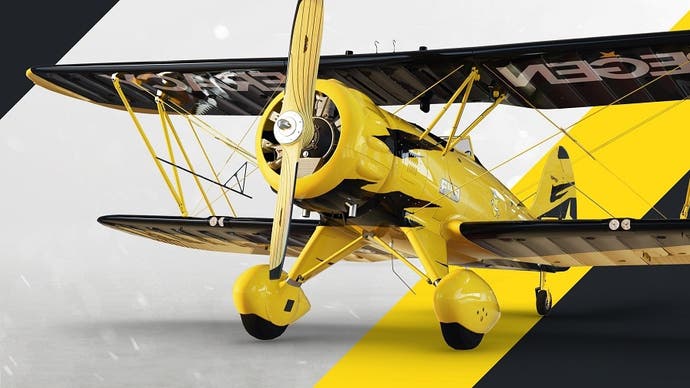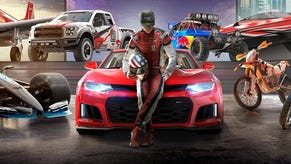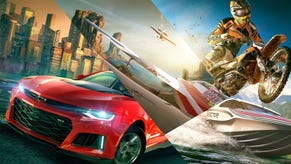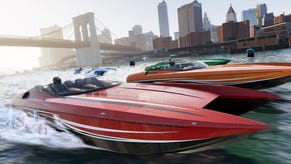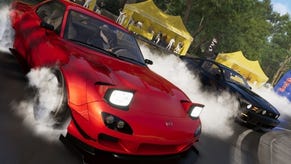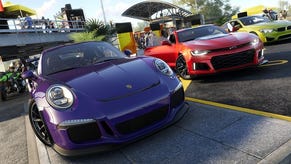The Crew 2 is a more joyful, less edgy breed of open world racer
Grand fest auto.
The Chevrolet Camaro ZL1 sportscar is, according to my notes, capable of exceeding 300 kilometres per hour on asphalt, and if you think that's impressive, wait till you see how fast it travels when it's plummeting uncontrollably through the atmosphere from a few miles up. As my time with The Crew 2 draws to a close, I turn my stuntplane skyward and hit the nitro. Rain speckles the camera; clouds knit and part with a surly magnificence. I spin the view side-on, watching the bright pink plane carve a track across the horizon like a finger running up a dirty windowpane. All the while, HUD notifications drip from the fuselage as the game steadily translates various unintended feats of aeronautics - a lazy corkscrew, a second of knife-flight - into points and multipliers.
After a moment the grey peels back and I emerge into late evening blue, tendrils of cloud brushing the wings in that horrifying, seductive way that makes you want to climb out and wade through them. I perform a loop-the-loop - the scoring systems go nuts - and sit back to enjoy the sights from inside the cockpit, wind rattling the frame. Then I click right stick and am suddenly behind the wheel of a sleek silver automobile. There are a few excitable seconds of freefall, a muted thud, and we're back in the outskirts of Miami, skidding through swampland. Thus the lovable madness at the heart of The Crew 2, an open world racer with high fidelity physics which lets you smash cars into Florida like meteors without so much as popping an airbag.

There's a levity to Ivory Tower's sequel that goes a long way, a festival spirit that carries across the game's world, aesthetic and interface, spicing up what is already a fairly absorbing range of vehicles and racing styles. Broadly, it's the same game as the 2014 original, giving you the run of a scaled-down United States that has been cheerfully wiped clean of people and their problems, its freeways, canyons, monuments and alleys reworked into a gigantic playground for private transport. It's the kind of place Google's driverless cars dream of going to when they're scrapped. The city layouts have been rebuilt from scratch, but this remains a landscape bristling with challenges and distractions, a thoroughly instrumentalised environment in which you seldom pass 10 seconds without triggering a multiplier. Won a circuit race? Congrats, here's your payout. Accidentally launched yourself from a rooftop into oncoming traffic after missing a turn? Well done, fill your boots. There are other players abroad in the world, too, all busy beating events and setting records that are dropped into your session, which creates a steady buzz of competition even should you decide to play through the whole thing alone.
The key difference is that where the first game promised freedom only to plunge your head into an RPG levelling trough and a weaksauce gangsta plot, The Crew 2 is very much about living in the moment. The premise does a lot of work here. Rather than a grindy retread of The Fast and The Furious, this is purely and simply a motorsports game, dedicated to the joy of hurling a gleaming machine across a receptive landscape. It's an ethos that deserves more interrogation - I'm curious to explore what values are revealed in the transformation of US cities into places where dirtbikes and pick-up trucks may run amok - but you can't deny its charm.
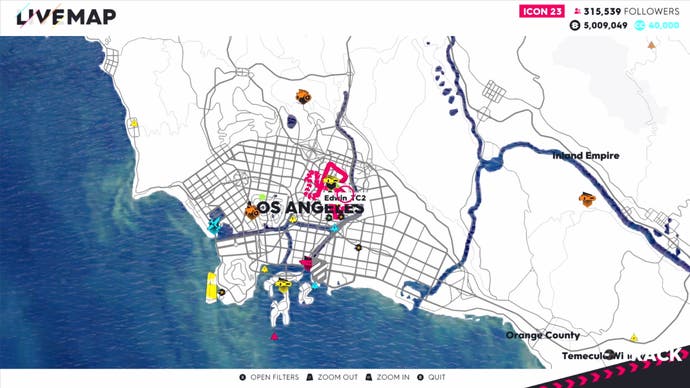
You see that lighter touch, especially, in the menu design, a heady play of clean whites, hot pinks and sizzling yellows that immediately put me in mind of Forza Horizon. You see it, too, in how rewards from events now manifest in-game as tumbling loot cannisters, coloured by rarity from green to purple. And you can see it, of course, in the ability to shapeshift into any car, boat or plane you've unlocked with a single click. The addition of water-based and airborne vehicles has obliged a full overhaul of The Crew's engine, which now sports a vastly more robust physics system, longer draw distances and any number of beautiful atmospheric effects. More importantly, perhaps, the morphing mechanic (together with a returning all-powerful fast travel option) both creates more variety and encourages you to make the most of it. One moment you're hurling a powerboat through twists of jungle, threading bridge posts and skimming across low mounds of vegetation to chop a few seconds off the corners. The next you're hacking ramps astride a dirt bike in California, or flying through hoops in a biplane over New York.
The first game's controversial levelling elements are still very prominent, in fairness. Each proper racing event has a recommended overall vehicle level, the sum of all the parts you have equipped, and if the game no longer brute-forces defeat via rubber-banding AI when you're under-levelled, you'll still need to grind for parts on occasion. It was hard to get a sense of the time commitment involved during my session because I was handed a bunch of tricked-out rides from the off. Similarly, I'm a little unsure how the handling will perform when you aren't driving something that has been customised to showcase the game, but it seems to be a vast improvement.
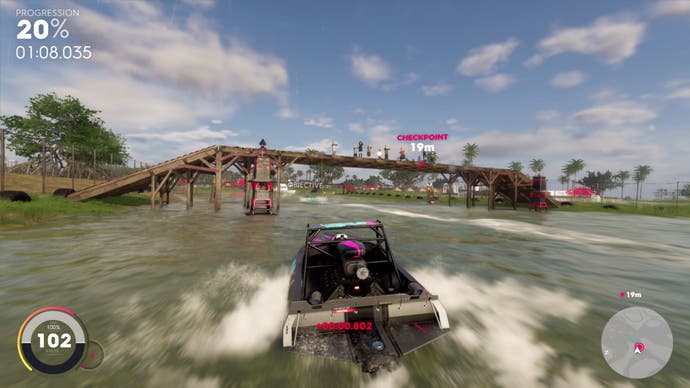
The cars, ranging from rumbling Dodge Challengers to supersonic F1 drag racers, feel less floaty than before, more predictable on the corners and less prone to oversteer, though collisions remain strangely ethereal, with vehicles sliding off each other like well-greased wrestlers. There's much more nuance to how the handling changes across surface types, too: bring a Porsche 911 GT3 to a muddy canyon race and you'll definitely struggle. The planes and boats are more primitive, however, with around half to a third the number of physics parameters per craft. The game's water is a delight to wrestle with - you'll feel the impact of your opponent's wake on the steering - and the glories of flight speak for themselves, but there are a few notable kludges where player convenience and fidelity don't quite agree, such as being able to take off more or less from a standstill. The bikes, finally, are driveable enough but somewhat hilarious, pinging all over the place as the game discreetly works to keep your rider upright while you do your utmost to flip yourself 180 degrees. It still feels more like a car's world than a full vehicle sandbox, in short, with planes, bikes and boats filling in as supporting acts.
Among The Crew 2's quieter touches are its hub spaces, sprawling apartments-cum-garages where you can wander around in first-person, drooling over the shiny hotrods in your possession and fiddling with their innards. There appears to be one of these hubs for each major city, and rather brilliantly, they have a real-time presence in the world. Gaze out across the New York coast as the sun rises and you might spot a few of your online friends, racing down the dock in powerboats. It's the mark of a game that has learned to savour the spectacle of itself, even as it automatically translates that spectacle into points and parts, a game that has set aside time to relish its own liveliness. The Crew 2 is probably more of a reboot than a sequel, and retains at least a few of its predecessor's sins. But it feels, nonetheless, like Ivory Tower has unearthed a kind of magic here which the original game never quite discovered.
